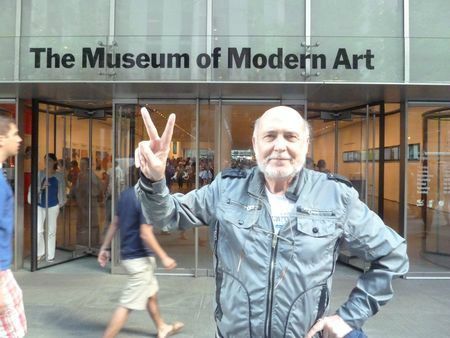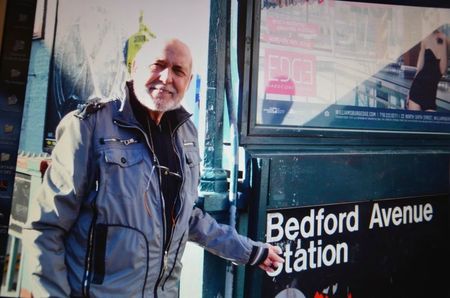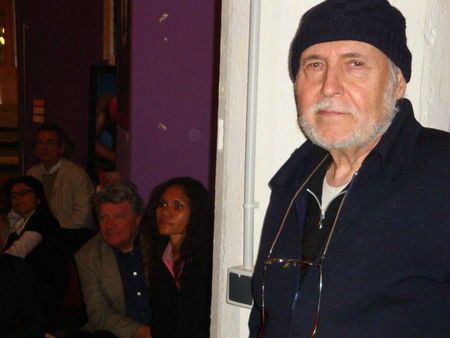ON-VERGE : FRED FOREST SPACE MEDIA IN NEW-YORK
INTERNATIONAL FRENCH ARTIST :
FRED FOREST FRED FOREST
FRED FOREST FRED FOREST ...
http://diaconescotv.canalblog.com/archives/2011/06/30/21347285.html
IN FRANCE : FLUX ET REFLUS
SOURCE : WEBNETMUSEUM FRED FOREST
by Ruth Erickson
The temporary occupation of space to confront powerful institutions has been on my mind as the Occupy Wall Street movement passes its month-long mark. The protestors condemn the increasing concentration of wealth into the hands of fewer and fewer people and the precarious existence of the other 99%. They have set up camps across the country, assembling patchwork plots of sleeping bags, hand-written signs, and stations for first aid, food, and media. The camps’ ad-hoc aesthetics visualize the very precariousness of the occupiers, who have been arrested, pepper sprayed, and beaten by the hundreds, but whose outraged sentiments seem to only grow with time.
In late September two events took place in New York City to draw attention to the inequalities and machinations of the art market through the temporary and insurrectionary claiming of space. On September 22, Occupy Wall Street activists infiltrated a Sotheby’s auction to protest the company’s anti-union policies and to show support for art handlers who have been locked out of contract negotiations since mid-summer. One by one protestors disrupted the auction by standing up and making damning pronouncements about, for instance, the CEO’s salary increases and the art handlers’ dwindling wages before being escorted out by Sotheby’s security.
On September 23, the longtime politically engaged French artist Fred Forest planned his Oeuvre Invisible for the Museum of Modern Art, which consisted of measuring a square meter and then occupying this space by placing ultra-sonic sound emitters. The project relates to Forest’s conception of objects as invisible systems in his book L’Œuvre-Système Invisible (Harmattan, 2006) and continues four decades of culture jamming actions by the now 78-year-old artist. Forest’s career of détournement began with his 1972 work Space Media when he inserted blank spaces in newspapers, the radio, and television and invited consumers to fill in the space with their free expressions and thoughts, thereby reversing the conventional direction of mass media communication. Oeuvre Invisible brings together two themes, in particular, that have occupied Forest throughout his career: critique of the art market and invisibility.
For his project Artistic Square Meter in 1977, Forest purchased land at the border of France and Switzerland and attempted to re-sell parcels at an art auction to illustrate speculation in the art market. When French authorities outlawed the sale, Forest replaced the square meter of land with a piece of fabric, which he bought, declared a “non-artistic square meter,” and sold for a couple thousand dollars. At Documenta in 1987, Forest created a 14,000 Hertz electromagnetic field by secretly placing transmitters in the within the Fredericum and then used local press to reveal the existence of the uninvited work. Continuing his critique of institutions, in 1994, Forest requested that the Centre Georges Pompidou make publicly available the price paid for Hans Haacke’s work Shapolsky et al. (1971), in which Haacke charts Shapolsky’s dirty real-estate dealings around New York City. Haacke’s work was famously censored at the time of exhibition by the Guggenheim Museum but has since become a canonical work of institutional critique, purchased by many major museums for millions of dollars. The publicly-funded museum refused, and in order to reveal this lack of transparency and speculation, Forest sued the museum in a multi-year court case, which which was finally founded in favor of the institution (see Forest’s Fonctionnements et dysfonctionnements de l’art contemporain, Harmattan, 2000). From March to September of 2011, Forest lived in New York City as a resident at Residency Unlimited and quickly set his sights on the MoMA for his next playful critique.
The project for the MoMA was the insurrectionary insertion of an invisible work, which would always remain beyond the grasp of institutional acquisition. Upon arriving with his group of volunteers at 4pm, Forest was greeted by three security agents who prohibited the work and threatened to call the New York City police if any performance took place. A twenty-minute conversation between Forest and the guards ensued about freedom of expression within the museum. The MoMA, Forest learned, only exhibits acquired or borrowed works, that is, works that have already participated in the art market. This is the very market being attacked sixty blocks further south by Occupy Wall Street and just a few block north by protestors at Sotheby’s. This is the market that Forest had made visible through the failure of his Oeuvre Invisible. After being trailed by security guards until leaving the building and area, Forest declared the creation of a new work, “The Conversation.”
Video Documentation of Sotheby protest: http://www.truth-out.org/occupy-wall-street-activists-disrupt-sothebys-art-auction/1316784991
Video Documentation by the Biennale Project of “The Conversation” by Fred Forest: http://www.youtube.com/watch?v=A_5rXN6nkx4, http://www.youtube.com/watch?v=wo4pneZF-0E, http://www.youtube.com/watch?v=92XnYf829i4
On Thursday, September 8th, 2011 at 4pm at the corner of Bedford Ave. and North 7th in Williamsburg, a group of individuals gathered for a re-animation of French artist Fred Forest’s work Sociological Walk in Brooklyn. Forest (born 1933 in Algeria, lives in Paris, France) is a pioneer of video art and a theorist, who created the first interactive environments in France simultaneously using computer and video as early as 1968. Sociological Walk in Brooklin (notice the spelling change) was first performed in November of 1973, in the São Paulo neighborhood Brooklin as part of that year’s Biennial. The walk is part performance, part ad-hoc school, and part sociological study, and encourages participants to rediscover their everyday environs through conversation and observation. Independent curator Ruth Erickson organized this most recent re-animation of Sociological Walk in Brooklyn, and interestingly Forest not only exists as a curatorial interest for Erickson, but as a focus for her current graduate work as a PhD candidate in the history of art as well.
During the following recent interview conducted on Facebook, I spoke with Erickson about the project as well as her relationship to the production of the artist’s history as a curator and historian.

"Sociological Walk in Brooklin," 1973.
Mike Bianco: I wanted to start by asking if you could to briefly describe the project.
Ruth Erickson: The project was a re-animation of Fred Forest’s Sociological Walk, which he first led for the 1973 Sao Paolo Biennial in the neighborhood of Brooklin. The walk is an active sociological study that seeks to produce new forms of engagement with an urban milieu through observation, conversation, and movement.
Of course, in 1973, the walk was done during Brazil’s military dictatorship, and so there are various political implications that could be considered in relation to an urban intervention.
The idea to re-animate it came from the fact that Fred has been living in Brooklyn (NY) for the past few months, and this new location is connected linguistically with Brooklin, Sao Paolo (a neighborhood named after Brooklyn).
MB: My first question is bifurcated into two parts since it’s about the same thing, which is looking at the recent trend of “revisiting” or “recreating” art works from the 1960s and 70s.
1) In recent history institutions have been realizing works posthumously and with either artistic or institutional interpretation: Smithson’s Floating Island (Whitney Museum, 2005), and Marina Abramovic’s Seven Easy Pieces (Guggenheim 2005) just to name a few. What are your thoughts on “recreating” works in the artist’s absence?
2) What is your position, as an emerging art historian/curator in reproducing a work with a living artist whom you’re writing about?
RE: I completely agree that we have witnessed a huge upsurge in the past 5-10 years of re-enactments or re-creations of 1960s/70s projects. I don’t think there is a blanket statement or reason as to why this happens, and I think each example has to be taken on a case-by-case basis, considering the reasons for the recreations and the different contexts being brought into dialogue by it. One obvious answer, which is nonetheless important to underscore, is the nostalgia that many of us feel for a politically engaged moment. Or maybe for a moment before political engagement and critique was funded by large institutions (the institutionalization of critique)….
I am not really sure what you mean by “position” on doing this project with Fred who is in my dissertation. Like, do I have an opinion about it or why did I want to collaborate in this way?
MB: I want to return to your first answer in a moment, but to respond to your second question first.
I think often times the role of the curator and – in my view – the art historian has a removed/distanced relationship from the artist. Recently we’ve been seeing various institutions asking artists to curate exhibitions – I.e. John Waters’ Absentee Landlord (The Walker Art Center 2011), Jeff Koons’ Skin Fruit (The New Museum 2010), etc. – but rarely do we see a situation where the role is reversed. The only thing that comes to mind are Jens Hoffman’s exhibitions where art works often fall into the role of characters or props to construct a narrative, but to actually “produce” or “collaborate” with an artist whom you’re historicizing to create a work seems like a very different position.
In ways it calls into question, and perhaps this is what I’m trying to get at, what the role of the contemporary art historian “is.”
(It’s a very interesting pickle that you’ve put in a jar.)
RE: Oh okay, yes, I agree. I only wanted to write a dissertation on living artists because I wanted their input in thinking about history (writing about it), which I see as a collaborative process of recreation. As I wrote in my blog post about the project, re-animating a project I had written about historically revealed so much about the work that I had never considered. For me, working on a project in the present made what was as yet a mythic image built up from documentary traces in my mind very real, problematic, and palpable.
I guess I think that every historian is recreating something, and the challenge to recreate something I normally study as history allowed me to experiment in ways that I would not feel comfortable as the “expert” and “distant” art historian.
It was largely about losing that sense of historical distance and expertise…by diving in.
I had super mixed emotions in the days following the re-animation because it threw everything into question.
MB: Hmm… almost as if a Picasso scholar could have had a time machine and gone back to have drinks with him and Braque. But there’s an element here of participation which I think is very different in terms of art history.
RE: Except that I wasn’t going back in time but trying to think about the viability of a 1970s project in the present.
MB: But why? As an experiment? What does it do for you as a historian? Or does it fulfill something else? I mean for me, it’s a bit like the omnipotent narrator has suddenly found herself on stage directing the show.
RE: I don’t have the option to return to the 1970s, and of course the project is totally different when done in NYC in 2011. For me, I think it was more of a challenge to work with Fred in this way and to ask about the present-day viability of some of the critical modes that I valorize from the 1970s.
So, I don’t consider myself an omnipotent narrator. In fact it is that position of the historian that the re-animation challenged for me.
MB: So then would you say your practice is about the artist participating in a more direct way in producing the history?
RE: That gets tricky too. Not exactly. I would say that I think an art historian writing on relatively recent history must draw first on primary sources and publicly available documents as well as their own historical and theoretical rigging, but he/she should always consider what shapes his/her contemporary readings. For me, the walk illustrated some of the changes that had taken place between 1973 and 2011 and thus highlighted the different context in which I write compared to the context in which the work was conceived and performed. Every historian has to chose how they want to use testimony and interviews and other highly subjective materials, but I see these as incredibly valuable and no less objective than our reading of historical documents.
I wanted an experiment about the activation of history. I don’t see Fred as collaborating in my dissertation directly, but I think he plays a central role in evolving my thinking about history. And thus is involved in the former task…
MB: But in a way don’t you need to write yourself into the history now?
RE: No, because I am not going to write about the 2011 walk. My dissertation work stops in 1980. Is my writing about the 1973 piece going to change because of the re-animation? Yes. Would it have changed if I visited Sao Paolo? Yes. How do we account for these changes that are inevitably going to take place in writing history?
MB: I mean it’s one thing to be the “author” of a history, but it’s another to both “author” and participant.
RE: But every author is a participant because they re-create history…
MB: Interesting, yes I agree.
RE: There is not history distinct from present experience for me.
MB: But, if I understand this correctly, it was as if you were recreating an experiment.
RE: There is no pure story I am trying to exhume.
MB: I wonder if this isn’t a situation specific to the artist’s practice.
RE: Fred would definitely have called the original project an experiment, and since we were re-creating the project insofar as we used the general structure and idea we were recreating an experiment. But I think we each had very different aims and ideas and desires in the recreation.
MB: In terms of your practice, do you see this as a one-time experiment, or something that you want to continue to try in the future?
RE: I’m very interested in the first question about the re-emergence of 1960/70s practices in contemporary art, and so I am sure I will be involved in a recreation again. However, for Fred’s work, I don’t foresee us doing another re-enactment. I think our next project will be a retrospective exhibition. Partly, this is because the “sociological practice” that is related to the original walk and his work from the 1970s may or may not (he would say probably not) be viable today because it doesn’t engage with the conditions that shape contemporary society. Like having a face-to-face conversation is so quaint seeming. He’d want to consider Facebook and the fact that we are having this conversation on a chat…
Ruth Erickson post-face from October 12, 2011: This conversation took place on Sept. 15, two days before the Occupy Wall Street protests blossomed first in New York City and then across the country and world. I talked about nostalgia for a politically engaged moment for leftist outrage, and that moment is upon us.
Ruth Erickson is a PhD candidate in the history of art at the University of Pennsylvania. She spent 2010-2011 as a Fulbright Fellow in Paris, where she researched the intersections of politics, social sciences, and art in post-1968 France through the history of the Sociological Art Collective (Hervé Fischer, Fred Forest, and Jean-Paul Thenot). She has published in such journals as Framework and via and presented her work in the USA, France, and England. From 2004-2007, she was Curator at the Firehouse Gallery, Burlington, VT, where she organized over two-dozen exhibitions.
 Mike Bianco, West Texas: regional editor
Mike Bianco, West Texas: regional editorMike Bianco is an artist and curator currently based in Marfa, Texas. Bianco earned his MA in Curatorial Practice from the California College of the Arts in 2007, and has been the director and founder of such projects as Queens Nail’s Projects and The Waypoint. Currently he is directing MUD, a ceramics gallery and studio located in Marfa.
GALLERY PHOTO FRED FOREST BY Gérard DIACONESCO ( AGENCY PRESS DIACONESCO.TV )
http://diaconescotv.canalblog.com/albums/fred_forest___retrospective___/index.html

/https%3A%2F%2Fprofilepics.canalblog.com%2Fprofilepics%2F4%2F2%2F426588.jpg)









/http%3A%2F%2Fstorage.canalblog.com%2F72%2F68%2F497307%2F124192998_o.jpg)
/http%3A%2F%2Ffile%3A%2F%2FC%3A%2FUsers%2FGRARD~1%2FAppData%2FLocal%2FIM%2FRuntime%2FSkin%2FE2FEE5~1%2FSTATIC~1.GIF)
/http%3A%2F%2Fstorage.canalblog.com%2F95%2F89%2F497307%2F110069183_o.jpg)
/http%3A%2F%2Fstorage.canalblog.com%2F42%2F39%2F497307%2F107863768_o.jpg)